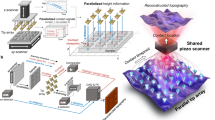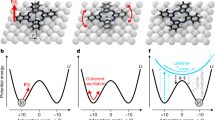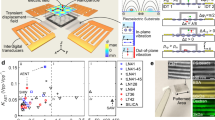Abstract
The use of scanning probe microscopy-based techniques to manipulate single molecules1 and deliver them in a precisely controlled manner to a specific target represents a significant nanotechnological challenge2,3. The ultimate physical limit in the design and fabrication of organic surfaces can be reached using this approach. Here we show that the atomic force microscope (AFM), which has been used extensively to investigate the stretching of individual molecules4,5,6,7,8,9,10,11,12, can deliver and immobilize single molecules, one at a time, on a surface. Reactive polymer molecules, attached at one end to an AFM tip, are brought into contact with a modified silicon substrate to which they become linked by a chemical reaction. When the AFM tip is pulled away from the surface, the resulting mechanical force causes the weakest bond — the one between the tip and polymer — to break. This process transfers the polymer molecule to the substrate where it can be modified by further chemical reactions.
This is a preview of subscription content, access via your institution
Access options
Subscribe to this journal
Receive 12 print issues and online access
$259.00 per year
only $21.58 per issue
Buy this article
- Purchase on Springer Link
- Instant access to full article PDF
Prices may be subject to local taxes which are calculated during checkout




Similar content being viewed by others
References
Gimzewski, J. K. & Joachim, C. Nanoscale science of single molecules using local probes. Science 283, 1683–1688 (1999).
Ginger, D. S., Zhang, H. & Mirkin, C. A. The evolution of dip-pen nanolithography. Angew. Chem. Int. Edn. 43, 30–45 (2004).
Loos, J. The art of SPM: scanning probe microscopy in materials science. Adv. Mater. 17, 1821–1833 (2005).
Rief, M., Gautel, M., Oesterhelt, F., Fernandez, J. M. & Gaub, H. E. Reversible unfolding of individual titin immunoglobulin domains by AFM. Science 276, 1109–1112 (1997).
Marszalek, P. E., Oberhauser, A. F., Pang, Y.-P. & Fernandez, J. M. Polysaccharide elasticity governed by chair-boat transitions of the glucopyranose ring. Nature 396, 661–664 (1998).
Smith, B. L. et al. Molecular mechanistic origin of the toughness of natural adhesives, fibres and composites. Nature 399, 761–763 (1999).
Clausen-Schaumann, H., Seitz, M., Krautbauer, R. & Gaub, H. E. Force spectroscopy with single bio-molecules. Curr. Opin. Chem. Biol. 4, 524–530 (2000).
Janshoff, A., Neitaert, M., Oberdoerfer, Y. & Fuchs, H. Force spectroscopy of molecular systems — single molecule spectroscopy of polymers and biomolecules. Angew. Chem. Int. Edn. 39, 3212–3237 (2000).
Hugel, T. & Seitz, M. The study of molecular interactions by AFM force spectroscopy. Macromol. Rapid Commun. 22, 989–1016 (2001).
Evans, E. Probing the relation between force–lifetime–and chemistry in single molecular bonds. Annu. Rev. Biophys. Biomol. Struct. 30, 105–128 (2001).
Bustamante, C., Chemla, Y. R., Forde, N. R. & Izhaky, D. Mechanical processes in biochemistry. Annu. Rev. Biochem. 73, 705–748 (2004).
Kienberger, F., Andreas Ebner, A., Gruber, H. J. & Hinterdorfer, P. Molecular recognition imaging and force spectroscopy of single biomolecules. Acc. Chem. Res. 39, 29–36 (2006).
Haschke, H., Miles, M. J. & Koutsos, V. Conformation of a single polyacrylamide molecule adsorbed onto a mica surface studied with atomic force microscopy. Macromolecules 37, 3799–3803 (2004).
Jérôme, C., Willet, N., Jérôme, R. & Duwez, A.-S. Electrografting of polymers onto AFM tips: a novel approach for chemical force microscopy and force spectroscopy. ChemPhysChem 5, 147–149 (2004).
Taunton, H. J., Toprakcioglu, C., Fetters, L. J. & Klein, J. Forces between surfaces bearing terminally anchored polymer chains in good solvents. Nature 332, 712–714 (1988).
Butt, H.-J. et al. Steric forces measured with the atomic force microscope at various temperatures. Langmuir 15, 2559–2565 (1999).
Zhang, W., Cui, S., Fu, Y. & Zhang, X. Desorption force of poly(4-vinylpyridine) layer assemblies from amino groups modified substrates. J. Phys. Chem. B 106, 12705–12708 (2002).
Bustamante, C., Marko, J. F. & Siggia, E. D. Entropic elasticity of λ-phage DNA. Science 265, 1599–1600 (1994).
Marko, J. F. & Siggia, E. D. Stretching DNA. Macromolecules 28, 8759–8770 (1995).
Grandbois, M., Beyer, M., Rief, M., Clausen-Schaumann, H. & Gaub, H. E. How strong is a covalent bond? Science 283, 1727–1730 (1999).
Beyer, M. K. & Clausen-Schaumann, H. Mechanochemistry: the mechanical activation of covalent bonds. Chem. Rev. 105, 2921–2948 (2005).
Gomes, J. R. B. & Gomes, J. A. N. F. Adsorption of the formyl species on transition metal surfaces. J. Electroanal. Chem. 483, 180–187 (2000).
Baxter, R. J., Teobaldi, G. & Zerbetto, F. Modeling the adsorption of alkanes on an Au(111) surface. Langmuir 19, 7335–7340 (2003).
Montalti, M. et al. Kinetics of place-exchange reactions of thiols on gold nanoparticles. Langmuir 19, 5172–5174 (2003).
Rapino, S. & Zerbetto, F. Modeling the stability and the motion of DNA nucleobases on the gold surface. Langmuir 21, 2512–2518 (2005).
Sheiko, S. S. Imaging of polymers using scanning force microscopy: from superstructures to individual molecules. Adv. Polym. Sci. 151, 61–174 (2000).
Kiriy, A. et al. Chemical contrasting in a single polymer molecule AFM experiment. J. Am. Chem. Soc. 125, 11202–11203 (2003).
Jérôme, C. et al. Preparation of reactive surfaces by electrografting. Chem. Commun. 2500–2501 (2003).
Dupres, V. et al. Nanoscale mapping and functional analysis of individual adhesins on living bacteria. Nature Methods 2, 515–520 (2005)
Fustin, C.-A., Glasser, G., Spiess, H. W. & Jonas, U. Parameters influencing the templated growth of colloidal crystals on chemically patterned surfaces. Langmuir 20, 9114–9123 (2004).
Acknowledgements
We thank C.-A. Fustin (UCL-CMAT) for preparing the amino-functionalized silicon substrates. The work was supported by the Belgian Science Policy in the frame of IUAP V/03 “Supramolecular Chemistry & Supramolecular Catalysis”.
Author information
Authors and Affiliations
Contributions
A.S.D. conceived and designed the experiments, S.C. performed the experiments, and S.G. and C.J. prepared the functionalized AFM tips and contributed to the experimental design. S.R. and F.Z. performed the calculations. A.S.D., S.C., S.R. and F.Z. analysed the data and discussed the results. A.S.D. and F.Z. co-wrote the paper.
Corresponding author
Ethics declarations
Competing interests
The authors declare no competing financial interests.
Supplementary information
Supplementary Information
Supplementary figures 1-4 (PDF 179 kb)
Rights and permissions
About this article
Cite this article
Duwez, AS., Cuenot, S., Jérôme, C. et al. Mechanochemistry: targeted delivery of single molecules. Nature Nanotech 1, 122–125 (2006). https://doi.org/10.1038/nnano.2006.92
Received:
Accepted:
Published:
Issue Date:
DOI: https://doi.org/10.1038/nnano.2006.92
This article is cited by
-
Shear-activation of mechanochemical reactions through molecular deformation
Scientific Reports (2024)
-
Atomic Force Microscopy: A Promising Tool for Deciphering the Pathogenic Mechanisms of Fungi in Cystic Fibrosis
Mycopathologia (2018)
-
On Stress-Induced Tribochemical Reaction Rates
Tribology Letters (2017)
-
Direct mechanochemical cleavage of functional groups from graphene
Nature Communications (2015)
-
A single synthetic small molecule that generates force against a load
Nature Nanotechnology (2011)



